Precision Agriculture in Brazil: The Trajectory of 25 Years of Scientific Research
Abstract
1. Introduction
2. Methodology for Surveying and Analyzing the Scientific Bibliography
2.1. Data Compilation
- Peer-reviewed papers excluding grey literature (e.g., conference proceedings, technical reports, books, PhD thesis, and Master’s dissertations);
- Studies conducted in Brazil involving one or more Brazilian author;
- Studies effectively related to PA (concepts, tools, and applications).
2.2. Data Analysis
3. Results and Discussion
3.1. Spatiotemporal Distribution of Precision Agriculture Publications in Brazil
- Up to 2000: In the first years after the introduction of PA in Brazil, only a few studies were published (totaling nine publications), mainly by pioneer PA research groups explicitly located in the southeast (i.e., São Paulo state) and south (i.e., Rio Grande do Sul state) regions of Brazil (Figure 4). In 1995 and 1999, the first PA symposia were organized at ESALQ/USP. In addition to the initiatives led by public universities, in this period, Embrapa also started to develop multiple projects related to PA into the National Agricultural Automation Program (called Program 12) [24] and the Brazilian Agricultural Technology Development Support Project—Prodetab, as reported by Inamasu and Bernardi [25]. In 1999, Embrapa published a document listing the infrastructure of PA in Brazil, including active researchers, companies, equipment, software, publications, and webpages related to PA [26].
- 2001–2005: A slight increase in the number of PA papers occurred in the early 2000s (Figure 4), with 33 papers being published in this period. This was boosted by the diffusion of PA concepts through classic textbooks and book chapters (e.g., Balastreire [27]; Borem et al. [28]; and Molin [11]), the disabling of GPS-selective availability signals making it more accessible and cheaper, the development of the first national equipment for the variable-rate application of fertilizers, and the field-application of PA by the first service providers. Furthermore, several initiatives emerged during this period that were led by universities, Embrapa, and private companies, such as Projeto Aquarius (https://projetoaquarius.agr.br/, accessed on 31 October 2022), which was created in 2001 by the Federal University of Santa Maria (in southern Brazil), and the 5-year PA macroprogram (phase 1), which was created by Embrapa in 2004. The Federal University of Viçosa (UFV) organized the International Symposium on Precision Farming (SIAP) in the years 2002, 2005, and 2007. The first Brazilian conference on PA was organized in 2004, a biannual event that included both the scientific community and industry in the same environment. Therefore, in the early 2000s, existing research groups had been consolidated, and new groups had emerged in the south, southeast, and central-west regions of Brazil (Figure 4).
- 2006–2010: The number of PA papers increased more significantly between 2005 and 2010 (Figure 3), with 80 papers being published in this period alone. Studies on PA were intensified in this period, driven by the diffusion of PA among the scientific community, crop consultants, and farmers, which is a sign of the solidification of the structure built in previous years. The 5-year PA macroprogram (phase 2) of the Embrapa was also launched in 2009, gathering dozens of researchers to work in diverse areas of PA. In terms of the spatial distribution of publications, it was observed that a small proportion of these publications started to come from the northeast region of Brazil (Figure 4).
- 2011 to present: The last decade has been marked by the most significant increase and internationalization of Brazilian PA publications (Figure 3). This increase in internationalization is likely due to the “Ciência sem fronteiras” government program (“Science without borders”; [29]) between 2011 and 2020, which funded undergraduate and PhD Brazilian students to carry out part of their research education at foreign institutions. The recent expansion of Brazilian science-based knowledge in PA, with 155 papers being published in the first quinquennium and 165 being published in the second, has been driven by multi-dimensional factors such as (i) investments in education that have promoted the expansion of public universities to the interior of the country (e.g., Support Program for Restructuring and Expansion Plans of Federal Universities—REUNI [30]) and the creation of new PA research groups (Figure 4); (ii) the implementation of PA as a subject integrated into agronomy and related under- and graduate courses [31] coupled with the publication of updated textbooks on PA (e.g., books mentioned in Table S2) with consolidated concepts and applications of PA for students and the broader community; (iii) public funding for research (for example, the Embrapa’s PA macro programs [25]); (iv) incentives for international scientific collaboration; v) the creation of PA-related commissions and associations (e.g., Brazilian Commission of PA (CBAP) into the Brazilian Ministry of Agriculture, Livestock and Supply (Brasil, 2012), the Brazilian Association of PA (AsBraAP—https://asbraap.org/, accessed on 31 October 2022), and the Brazilian Association of Service Providers in PA (ABPSAP—https://www.abpsap.org.br/, accessed on 31 October 2022) as well as National Strategic Agenda for PA—2014–2030 [32]; and (vi) the development and popularization of new technologies applied to agriculture (e.g., Internet, smartphones, drones, machine learning, etc.).
3.2. Scientific Collaboration Network on Precision Agriculture
3.3. Advances in and Perspectives on Precision Agriculture Research Areas in Brazil
3.3.1. Global Navigation Satellite System (GNSS) Applications
3.3.2. Soil Management
3.3.3. Plant Management
3.3.4. Phytosanitary Management
3.3.5. Machinery, Equipment, and Autonomous Vehicles
3.3.6. Remote Sensing and Unmanned Aerial Vehicles (UAVs)
3.3.7. Decision Support Tools
3.4. Sector Organization and Public Policies for Precision Agriculture in Brazil
3.5. Final Remarks
Supplementary Materials
Author Contributions
Funding
Institutional Review Board Statement
Data Availability Statement
Acknowledgments
Conflicts of Interest
Appendix A

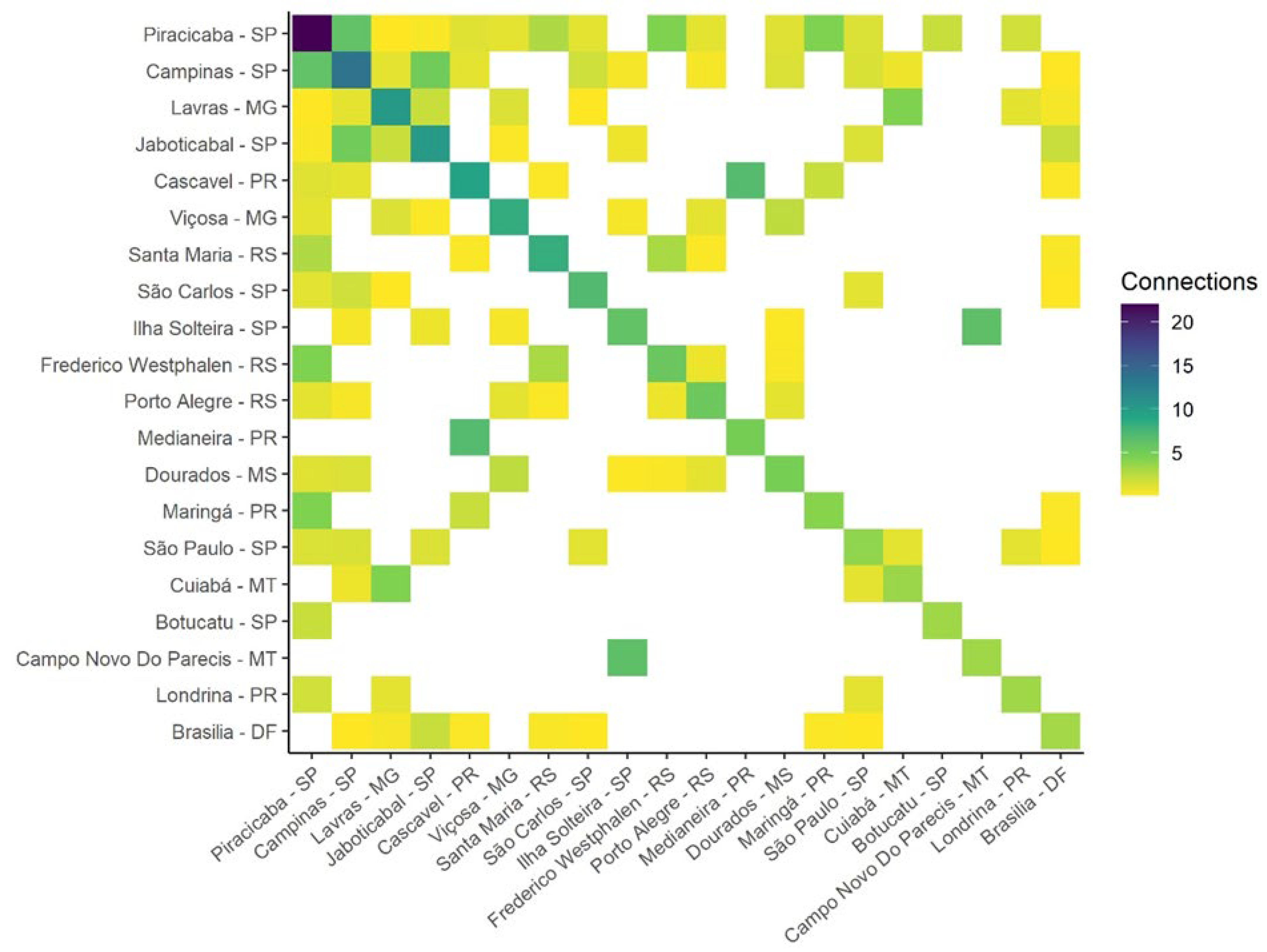
References
- Tilman, D.; Balzer, C.; Hill, J.; Befort, B.L. Global food demand and the sustainable intensification of agriculture. Proc. Natl. Acad. Sci. USA 2011, 108, 20260–20264. [Google Scholar] [CrossRef] [PubMed]
- U.S. Energy Information Administration (EIA). International Energy Outlook—IEO; Energy Information Administration: Washington, DC, USA, 2019. [Google Scholar]
- Foley, J.A.; DeFries, R.; Asner, G.P.; Barford, C.; Bonan, G.; Carpenter, S.R.; Chapin, F.S.; Coe, M.T.; Daily, G.C.; Gibbs, H.K.; et al. Global Consequences of Land Use. Science 2005, 309, 570–574. [Google Scholar] [CrossRef] [PubMed]
- Smith, P.; House, J.I.; Bustamante, M.; Sobocká, J.; Harper, R.; Pan, G.; West, P.C.; Clark, J.M.; Adhya, T.; Rumpel, C.; et al. Global change pressures on soils from land use and management. Glob. Chang. Biol. 2016, 22, 1008–1028. [Google Scholar] [CrossRef]
- Foley, J.A.; Ramankutty, N.; Brauman, K.A.; Cassidy, E.S.; Gerber, J.S.; Johnston, M.; Mueller, N.D.; O’Connell, C.; Ray, D.K.; West, P.C.; et al. Solutions for a cultivated planet. Nature 2011, 478, 337–342. [Google Scholar] [CrossRef] [PubMed]
- Bongiovanni, R.; Lowenberg-Deboer, J. Precision Agriculture and Sustainability. Precis. Agric. 2004, 5, 359–387. [Google Scholar] [CrossRef]
- Gebbers, R.; Adamchuk, V.I. Precision Agriculture and Food Security. Science 2010, 327, 828–831. [Google Scholar] [CrossRef]
- Finger, R.; Swinton, S.M.; El Benni, N.; Walter, A. Precision farming at the nexus of agricultural production and the environment. Annu. Rev. Resour. Econ. 2019, 11, 313–335. [Google Scholar] [CrossRef]
- Lehmann, J.; Bossio, D.A.; Kögel-Knabner, I.; Rillig, M.C. The concept and future prospects of soil health. Nat. Rev. Earth Environ. 2020, 1, 544–553. [Google Scholar] [CrossRef]
- Linsley, C.M.; Bauer, F.C. Test Your Soil for Acidity; Circular, University of Illinois, Agricultural Experiment Station: Champaign, IL, USA, 1929. [Google Scholar]
- Molin, J.P. Agricultura de Precisão: O Gerenciamento da Variabilidade; ESALQ/USP: Piracicaba, Brazil, 2001. [Google Scholar]
- Zhang, N.; Wang, M.; Wang, N. Precision agriculture—A worldwide overview. Comput. Electron. Agric. 2002, 36, 113–132. [Google Scholar] [CrossRef]
- Mulla, D.; Khosla, R. Historical evolution and recent advances in precision farming. Soil-Specif. Farming Precis. Agric. 2016, 1, 35. [Google Scholar] [CrossRef]
- Pallottino, F.; Biocca, M.; Nardi, P.; Figorilli, S.; Menesatti, P.; Costa, C. Science mapping approach to analyze the research evolution on precision agriculture: World, EU and Italian situation. Precis. Agric. 2018, 19, 1011–1026. [Google Scholar] [CrossRef]
- Pamplona, J.B.; Rodrigues Silva, M.A. Adoção da Agricultura de Precisão na América do Sul: O Estado da Arte em Argentina, Brasil e Colômbia. Gestão Reg. 2019, 35, 105. [Google Scholar] [CrossRef]
- Lowenberg-DeBoer, J.; Erickson, B. Setting the Record Straight on Precision Agriculture Adoption. Agron. J. 2019, 111, 1552–1569. [Google Scholar] [CrossRef]
- Bolfe, É.L.; de Jorge, L.A.C.; Sanches, I.D.; Luchiari Júnior, A.; da Costa, C.C.; de Victoria, C.D.; Inamasu, R.Y.; Grego, C.R.; Ferreira, V.R.; Ramirez, A.R. Precision and Digital Agriculture: Adoption of Technologies and Perception of Brazilian Farmers. Agriculture 2020, 10, 653. [Google Scholar] [CrossRef]
- CONAB. Produção Agrícola—Safra: Série histórica dos grãos. 2020. Available online: https://www.conab.gov.br/info-agro/safras/graos (accessed on 4 November 2022).
- Mendes, L.C.; Tormena, C.A.; Cherubin, M.R.; Karlen, D.L. Soil health assessment and maintenance in Central and South Central Brazil. In Managing Soil Health for Sustainable Agriculture; Reicosky, D., Ed.; Burleigh Dodds Science Publishing: Cambridge, UK, 2018; pp. 379–415. [Google Scholar]
- IBGE. Instituto Brasileiro de Geografia e Estatística. SIDRA—Sistema IBGE de Recuperação Automática: Censo Agropecuário. 2017. Available online: https://www.ibge.gov.br/estatisticas/sociais/populacao/9127-pesquisa-nacional-por-amostra-de-domicilios.html?edicao=9451&t=downloads (accessed on 22 October 2022).
- Molin, J.P. Agricultura de precisão, parte I: O que é e estado da arte em sensoriamento. Eng. Agrícola 1997, 17, 97–107. [Google Scholar]
- Molin, J.P. Agricultura de precisão. Parte 2: Diagnóstico, aplicação localizada e considerações econômicas. Eng. Agrícola 1997, 17, 108–121. [Google Scholar]
- Aleixandre-Tudó, J.L.; Castelló-Cogollos, L.; Aleixandre, J.L.; Aleixandre-Benavent, R. Bibliometric and social network analysis in scientific research on precision agriculture. Curr. Sci. 2018, 115, 1653–1667. [Google Scholar] [CrossRef]
- EMBRAPA. Programa Nacional de Automação Agropecuária. 2001. Available online: https://www.embrapa.br/busca-de-publicacoes/-/publicacao/580397/relatorio-de-atividades-1994-2001-programa-nacional-de-automacao-agropecuaria (accessed on 4 November 2022).
- Inamasu, R.Y.; de Bernardi, A.C.C. Agricultura de Precisão. In Agricultura de Precisão: Resultados de um Novo Olhar; Bernardi, A.C.d.C., Naime, J.d.M., Resende, Á.V.d., Bassoi, L.H., Inamasu, R.Y., Eds.; Embrapa: Brasilia, Brazil, 2014. [Google Scholar]
- Mesquita, C.d.M. Infra Estrutura da Agricultura de Precisão no Brasil; Embrapa Soja: Londrina, Brazil, 1999. [Google Scholar]
- Balastreire, L.A. O Estado-da-Arte da Agricultura de Precisão no Brasil; Ed. do Autor: Piracicaba, Brazil, 2000. [Google Scholar]
- Borem, A.; Del Giudice, M.P.; Queiroz, D.M.; Montovani, E.C.; Ferreira, L.R.; Valle, F.X.R.; Gomide, R.L. Agricultura de Precisão; UFV: Viçosa, Brazil, 2000. [Google Scholar]
- Nery, M.B.M. Science Without Borders’ Contributions to Internationalization of Brazilian Higher Education. J. Stud. Int. Educ. 2018, 22, 371–392. [Google Scholar] [CrossRef]
- BRASIL. Decreto no 6.096, de 24 de abril de 2007; Diário Oficial da Repúbica Federativa do Brasil: 2007. Available online: http://www.planalto.gov.br/ccivil_03/_ato2007-2010/2007/decreto/d6096.htm (accessed on 4 November 2022).
- Moraes, M.P. O ensino e a Pesquisa em Agricultura de Precisão nos Cursos de Agronomia das Instituições de Ensino Superior (IES) Brasileiras; Universidade Federal de Santa Maria: Santa Maria, Brazil, 2021. [Google Scholar]
- MAPA Agenda estratégica. Agricultura de Precisão, 2014–2030; Oficina de textos: São Paulo, Brazil, 2014. [Google Scholar]
- Donagemma, G.K.; de Freitas, P.L.; Balieiro, F.d.C.; Fontana, A.; Spera, S.T.; Lumbreras, J.F.; Viana, J.H.M.; de Araújo Filho, J.C.; dos Santos, F.C.; de Albuquerque, M.R.; et al. Characterization, agricultural potential, and perspectives for the management of light soils in Brazil. Pesqui. Agropecuária Bras. 2016, 51, 1003–1020. [Google Scholar] [CrossRef]
- Lindblom, J.; Lundström, C.; Ljung, M.; Jonsson, A. Promoting sustainable intensification in precision agriculture: Review of decision support systems development and strategies. Precis. Agric. 2017, 18, 309–331. [Google Scholar] [CrossRef]
- Molin, J.P. Utilização de GPS em agricultura de precisão. Eng. Agrícola 1998, 17, 121–132. [Google Scholar]
- Stabile, M.C.C.; Balastreire, L.A. Comparação de três receptores GPS para uso em agricultura de precisão. Eng. Agrícola 2006, 26, 215–223. [Google Scholar] [CrossRef]
- Baio, F.H.R.; Balastreire, L.A.; Torres, F.; Ribeiro Filho, A.C. Avaliação da acurácia de uma barra de luz utilizada na agricultura de precisão, em relação ao marcador de espuma. Rev. Bras. Eng. Agrícola E Ambient. 2001, 5, 357–360. [Google Scholar] [CrossRef][Green Version]
- Baio, F.H.R.; Moratelli, R.F. Avaliação da acurácia no direcionamento com piloto automático e contraste da capacidade de campo operacional no plantio mecanizado da cana-de-açúcar. Eng. Agrícola 2011, 31, 367–375. [Google Scholar] [CrossRef][Green Version]
- Spogli, L.; Alfonsi, L.; Romano, V.; De Franceschi, G.; Francisco, G.M.J.; Shimabukuro, M.H.; Bougard, B.; Aquino, M. Assessing the GNSS scintillation climate over Brazil under increasing solar activity. J. Atmos. Solar-Terrestrial Phys. 2013, 105, 199–206. [Google Scholar] [CrossRef]
- Vadakke Veettil, S.; Aquino, M.; Marques, H.A.; Moraes, A. Mitigation of ionospheric scintillation effects on GNSS precise point positioning (PPP) at low latitudes. J. Geod. 2020, 94, 15. [Google Scholar] [CrossRef]
- Perez-Ruiz, M.; Martínez-Guanter, J.; Upadhyaya, S.K. High-precision GNSS for agricultural operations. In GPS and GNSS Technology in Geosciences; Elsevier: Amsterdam, The Netherlands, 2021; pp. 299–335. [Google Scholar]
- Albuquerque, J.A.; Reinert, D.J.; Fiorin, J.E. Variabilidade de solo e planta em Podzólico Vermelho-Amarelo. Rev. Bras. Ciência Do Solo 1996, 20, 151–157. [Google Scholar]
- Berg, M.; Klamt, E. Variabilidade espacial de características de solos na região do Planalto Médio, RS: I. análise da variância por amostragem aninhada. Rev. Bras. Ciência Do Solo 1997, 21, 393–399. [Google Scholar] [CrossRef][Green Version]
- Couto, E.G.; Klamt, E. Variabilidade espacial de micronutrientes em solo sob pivô central no sul do Estado de Mato Grosso. Pesqui. Agropecuária Bras. 1999, 34, 2321–2329. [Google Scholar] [CrossRef][Green Version]
- Corá, J.E.; Beraldo, J.M.G. Variabilidade espacial de atributos do solo antes e após calagem e fosfatagem em doses variadas na cultura de cana-de-açúcar. Eng. Agrícola 2006, 26, 374–387. [Google Scholar] [CrossRef][Green Version]
- da Silva Carneiro, J.S.; dos Santos, A.C.M.; Fidelis, R.R.; da Silva Neto, S.P.; dos Santos, A.C.; da Silva, R.R. Diagnóstico e manejo da variabilidade espacial da fertilidade do solo no cerrado do Piauí. Rev. Ciências Agroambientais 2016, 14, 2. [Google Scholar] [CrossRef]
- Santi, L.; Junior, M.D.; Cherubin, M.R.; Telmo, J.C.A.; Mateus, T.E.; Andr eacute, L.V.; Wilfrand, F.B.H. Soil physical and hydraulic changes in different yielding zones under no-tillage in Brazil. African J. Agric. Res. 2016, 11, 1326–1335. [Google Scholar] [CrossRef][Green Version]
- Cruz, J.S.; de Assis, R.N., Jr.; Matias, S.S.R.; Camacho-Tamayo, J.H.; de Tavares, R.C. Análise espacial de atributos físicos e carbono orgânico em argissolo vermelho-amarelo cultivado com cana-de-açúcar. Ciência E Agrotecnologia 2010, 34, 271–278. [Google Scholar] [CrossRef]
- Silva, R.A.; Siqueira, G.M.; Costa, M.K.L.; Guedes Filho, O.; Silva, Ê.F.d.F. Spatial Variability of Soil Fauna Under Different Land Use and Managements. Rev. Bras. Ciência Do Solo 2018, 42, 1–17. [Google Scholar] [CrossRef]
- Nanni, M.R.; Povh, F.P.; Demattê, J.A.M.; de Oliveira, R.B.; Chicati, M.L.; Cezar, E. Optimum size in grid soil sampling for variable rate application in site-specific management. Sci. Agric. 2011, 68, 386–392. [Google Scholar] [CrossRef]
- Cherubin, M.R.; Santi, A.L.; Eitelwein, M.T.; Amado, T.J.C.; Simon, D.H.; Damian, J.M. Dimensão da malha amostral para caracterização da variabilidade espacial de fósforo e potássio em Latossolo Vermelho. Pesqui. Agropecuária Bras. 2015, 50, 168–177. [Google Scholar] [CrossRef]
- Viscarra Rossel, R.A.; Lobsey, C. Scoping Review of Proximal Soil Sensors for Grain Growing; CSIRO: Canberra: Australia, 2016. [Google Scholar]
- Bottega, E.L.; Bottega, S.P.; Silva, S.A.; Queiroz, D.M.; Souza, C.M.A.; Rafull, L.Z.L. Variabilidade espacial da resistência do solo à penetração em um Latossolo Vermelho distroférrico. Rev. Bras. Ciências Agrárias—Braz. J. Agric. Sci. 2011, 6, 331–336. [Google Scholar] [CrossRef]
- Debiasi, H.; Franchini, J.C.; Oliveira, F.A.; Machado, T.M. Ajuste de grades amostrais para o mapeamento da resistência à penetração de um Latossolo Bruno. In Agricultura de Precisão: Um Novo Olhar; Inamasu, B.Y., Naime, J.M., Resende, A.V., Bassoi, L.H., Eds.; Embrapa: São Carlos, Brazil, 2012. [Google Scholar]
- Kuang, B.; Mahmood, H.S.; Quraishi, M.Z.; Hoogmoed, W.B.; Mouazen, A.M.; van Henten, E.J. Sensing Soil Properties in the Laboratory, In Situ, and On-Line. Adv. Agron. 2012, 114, 155–223. [Google Scholar] [CrossRef]
- Castrignanò, A.; Buttafuoco, G.; Quarto, R.; Vitti, C.; Langella, G.; Terribile, F.; Venezia, A. A Combined Approach of Sensor Data Fusion and Multivariate Geostatistics for Delineation of Homogeneous Zones in an Agricultural Field. Sensors 2017, 17, 2794. [Google Scholar] [CrossRef]
- Demattê, J.A.; Campos, R.C.; Alves, M.C.; Fiorio, P.R.; Nanni, M.R. Visible–NIR reflectance: A new approach on soil evaluation. Geoderma 2004, 121, 95–112. [Google Scholar] [CrossRef]
- Demattê, J.A.M.; Galdos, M.V.; Guimarães, R.V.; Genú, A.M.; Nanni, M.R.; Zullo, J. Quantification of tropical soil attributes from ETM+/LANDSAT-7 data. Int. J. Remote Sens. 2007, 28, 3813–3829. [Google Scholar] [CrossRef]
- Molin, J.P.; Faulin, G.D.C. Spatial and temporal variability of soil electrical conductivity related to soil moisture. Sci. Agric. 2013, 70, 1–5. [Google Scholar] [CrossRef]
- de Silva, F.C.; Molin, J.P. On-the-go tropical soil sensing for pH determination using ion-selective electrodes. Pesqui. Agropecuária Bras. 2018, 53, 1189–1202. [Google Scholar] [CrossRef]
- Franceschini, M.H.D.; Demattê, J.A.M.; Kooistra, L.; Bartholomeus, H.; Rizzo, R.; Fongaro, C.T.; Molin, J.P. Effects of external factors on soil reflectance measured on-the-go and assessment of potential spectral correction through orthogonalisation and standardisation procedures. Soil Tillage Res. 2018, 177, 19–36. [Google Scholar] [CrossRef]
- Sanches, G.M.; Magalhães, P.S.G.; Remacre, A.Z.; Franco, H.C.J. Potential of apparent soil electrical conductivity to describe the soil pH and improve lime application in a clayey soil. Soil Tillage Res. 2018, 175, 217–225. [Google Scholar] [CrossRef]
- Sanches, G.M.; de Paula, M.T.N.; Magalhães, P.S.G.; Duft, D.G.; Vitti, A.C.; Kolln, O.T.; Borges, B.M.M.N.; Franco, H.C.J. Precision production environments for sugarcane fields. Sci. Agric. 2019, 76, 10–17. [Google Scholar] [CrossRef]
- Sanches, G.M.; Graziano Magalhães, P.S.; dos Santos Luciano, A.C.; Camargo, A.L.; Franco, H.C.J. Comprehensive assessment of spatial soil variability related to topographic parameters in sugarcane fields. Geoderma 2020, 362, 114012. [Google Scholar] [CrossRef]
- Barbieri, D.M.; Marques Júnior, J.; Pereira, G.T. Variabilidade espacial de atributos químicos de um argissolo para aplicação de insumos à taxa variável em diferentes formas de relevo. Eng. Agrícola 2008, 28, 645–653. [Google Scholar] [CrossRef][Green Version]
- Da Silva, J.F., Jr.; Marques, J., Jr.; Camargo, L.A.; Teixeira, D.D.B.; Panosso, A.R.; Pereira, G.T. Simulação geoestatística na caracterização espacial de óxidos de ferro em diferentes pedoformas. Rev. Bras. Ciência Do Solo 2012, 36, 1690–1703. [Google Scholar] [CrossRef]
- Terra, F.S.; Demattê, J.A.M.; Viscarra Rossel, R.A. Spectral libraries for quantitative analyses of tropical Brazilian soils: Comparing vis–NIR and mid-IR reflectance data. Geoderma 2015, 255–256, 81–93. [Google Scholar] [CrossRef]
- Demattê, J.A.M.; Ramirez-Lopez, L.; Marques, K.P.P.; Rodella, A.A. Chemometric soil analysis on the determination of specific bands for the detection of magnesium and potassium by spectroscopy. Geoderma 2017, 288, 8–22. [Google Scholar] [CrossRef]
- de Santana, F.B.; de Souza, A.M.; Poppi, R.J. Visible and near infrared spectroscopy coupled to random forest to quantify some soil quality parameters. Spectrochim. Acta Part A Mol. Biomol. Spectrosc. 2018, 191, 454–462. [Google Scholar] [CrossRef] [PubMed]
- Tavares, T.R.; Molin, J.P.; Nunes, L.C.; Alves, E.E.N.; Melquiades, F.L.; de Carvalho, H.W.P.; Mouazen, A.M.; de Carvalho, H.W.P.; Mouazen, A.M. Effect of X-Ray Tube Configuration on Measurement of Key Soil Fertility Attributes with XRF. Remote Sens. 2020, 12, 963. [Google Scholar] [CrossRef]
- Silva, S.H.G.; Ribeiro, B.T.; Guerra, M.B.B.; de Carvalho, H.W.P.; Lopes, G.; Carvalho, G.S.; Guilherme, L.R.G.; Resende, M.; Mancini, M.; Curi, N.; et al. pXRF in tropical soils: Methodology, applications, achievements and challenges. Adv. Agron. 2021, 167, 1–62. [Google Scholar] [CrossRef]
- Demattê, J.A.M.; Dotto, A.C.; Bedin, L.G.; Sayão, V.M.; de Souza, A.B. Soil analytical quality control by traditional and spectroscopy techniques: Constructing the future of a hybrid laboratory for low environmental impact. Geoderma 2019, 337, 111–121. [Google Scholar] [CrossRef]
- Guerrero, A.; De Neve, S.; Mouazen, A.M. Current sensor technologies for in situ and on-line measurement of soil nitrogen for variable rate fertilization: A review. Adv. Agron. 2021, 168, 1–38. [Google Scholar] [CrossRef]
- Balastreire, L.A.; Elias, A.I.; Amaral, J.R. do Agricultura de precisão: Mapeamento da produtividade da cultura de milho. Eng. Na Agric. 1997, 5, 308–324. [Google Scholar]
- Menegatti, L.A.A.; Molin, J.P. Remoção de erros em mapas de produtividade via filtragem de dados brutos. Rev. Bras. Eng. Agrícola Ambient. 2004, 8, 126–134. [Google Scholar] [CrossRef]
- Santos, A.O.; Maziero, J.V.G.; Cavalli, A.C.; Valeriano, M.M.; de Oliveira, H.; Moraes, J.F.L.; Yanai, K. Monitoramento localizado da produtividade de milho cultivado sob irrigação. Rev. Bras. Eng. Agrícola Ambient. 2001, 5, 88–95. [Google Scholar] [CrossRef]
- Da Silva, F.M.; de Souza, Z.M.; de Figueiredo, C.A.P.; Marques Júnior, J.; Machado, R.V. Variabilidade espacial de atributos químicos e de produtividade na cultura do café. Ciência Rural 2007, 37, 401–407. [Google Scholar] [CrossRef][Green Version]
- Amado, T.J.C.; Pes, L.Z.; Lemainski, C.L.; Schenato, R.B. Atributos químicos e físicos de latossolos e sua relação com os rendimentos de milho e feijão irrigados. Rev. Bras. Ciência Solo 2009, 33, 831–843. [Google Scholar] [CrossRef]
- Konopatzki, M.R.S.; Souza, E.G.; Nóbrega, L.H.P.; Uribe-Opazo, M.A.; Suszek, G. Spatial variability of yield and other parameters associated with pear trees. Eng. Agrícola 2012, 32, 381–392. [Google Scholar] [CrossRef][Green Version]
- De Souza, Z.M.; Cerri, D.G.P.; Colet, M.J.; Rodrigues, L.H.A.; Magalhães, P.S.G.; Mandoni, R.J.A. Análise dos atributos do solo e da produtividade da cultura de cana-de-açúcar com o uso da geoestatística e árvore de decisão. Ciência Rural. 2010, 40, 840–847. [Google Scholar] [CrossRef]
- Montanari, R.; Lima, R.C.; Bonini, A.S.; Marques, L.S.; Carvalho, M.P.; Paz Ferreiro, J.; Costa, N.R.; Minguini, R. Variabilidade dos atributos de um latossolo vermelho sob plantio direto no cerrado brasileiro e produtividade da soja. Cad. Lab. Xeol. Laxe 2011, 36, 219–237. Available online: http://hdl.handle.net/11449/72734 (accessed on 1 November 2022).
- de Pias, O.H.C.; Basso, C.J.; Santi, A.L.; Bier, D.R.; Pinto, M.A.B. Mapeamento da produção de massa seca do Tifton 85 e sua correlação com os atributos químicos do solo. Semin. Ciências Agrárias 2015, 36, 2093. [Google Scholar] [CrossRef]
- Colet, M.J.; Weirich Neto, P.H.; Garbuio, P.W.; Schimandeiro, A. Processo de semeadura e o rendimento do milho na região dos Campos Gerais do Paraná. Ciência Rural 2007, 37, 994–999. [Google Scholar] [CrossRef]
- Vian, A.L.; Santi, A.L.; Amado, T.J.C.; Cherubin, M.R.; Simon, D.H.; Damian, J.M.; Bredemeier, C. Variabilidade espacial da produtividade de milho irrigado e sua correlação com variáveis explicativas de planta. Ciência Rural 2016, 46, 464–471. [Google Scholar] [CrossRef]
- Hörbe, T.A.N.; Amado, T.J.C.; Ferreira, A.O.; Alba, P.J. Optimization of corn plant population according to management zones in Southern Brazil. Precis. Agric. 2013, 14, 450–465. [Google Scholar] [CrossRef]
- Corassa, G.M.; Amado, T.J.C.; Strieder, M.L.; Schwalbert, R.; Pires, J.L.F.; Carter, P.R.; Ciampitti, I.A. Optimum Soybean Seeding Rates by Yield Environment in Southern Brazil. Agron. J. 2018, 110, 2430–2438. [Google Scholar] [CrossRef]
- Biffi, L.J.; Rafaeli Neto, S.L. Comportamento espacial de variáveis agronômicas da maçã “Fuji” durante dois anos de observações no planalto serrano de Santa Catarina. Rev. Bras. Frutic. 2008, 30, 975–980. [Google Scholar] [CrossRef][Green Version]
- Oliveira, P.C.G.; Farias, P.R.S.; Lima, H.V.; Fernandes, A.R.; Oliveira, F.A.; Pita, J.D. Variabilidade espacial de propriedades químicas do solo e da produtividade de citros na Amazônia Oriental. Rev. Bras. Eng. Agrícola e Ambient. 2009, 13, 708–715. [Google Scholar] [CrossRef][Green Version]
- Colaço, A.F.; Molin, J.P. Variable rate fertilization in citrus: A long term study. Precis. Agric. 2017, 18, 169–191. [Google Scholar] [CrossRef]
- Colaço, A.; Trevisan, R.; Molin, J.; Rosell-Polo, J.; Escolà, A. A Method to Obtain Orange Crop Geometry Information Using a Mobile Terrestrial Laser Scanner and 3D Modeling. Remote Sens. 2017, 9, 763. [Google Scholar] [CrossRef]
- Grohs, D.S.; Bredemeier, C.; Poletto, N.; Mundstock, C.M. Validação de modelo para predição do potencial produtivo de trigo com sensor óptico ativo. Pesqui. Agropecuária Bras. 2011, 46, 446–449. [Google Scholar] [CrossRef]
- Bredemeier, C.; Variani, C.; Almeida, D.; Rosa, A.T. Estimativa do potencial produtivo em trigo utilizando sensor óptico ativo para adubação nitrogenada em taxa variável. Ciência Rural 2013, 43, 1147–1154. [Google Scholar] [CrossRef]
- Amaral, L.R.; Molin, J.P.; Portz, G.; Finazzi, F.B.; Cortinove, L. Comparison of crop canopy reflectance sensors used to identify sugarcane biomass and nitrogen status. Precis. Agric. 2015, 16, 15–28. [Google Scholar] [CrossRef]
- Trevisan, R.; Vilanova Júnior, N.; Eitelwein, M.; Molin, J. Management of Plant Growth Regulators in Cotton Using Active Crop Canopy Sensors. Agriculture 2018, 8, 101. [Google Scholar] [CrossRef]
- Amaral, L.R.; Trevisan, R.G.; Molin, J.P. Canopy sensor placement for variable-rate nitrogen application in sugarcane fields. Precis. Agric. 2018, 19, 147–160. [Google Scholar] [CrossRef]
- Damian, J.M.; Santi, A.L.; Fornari, M.; Da Ros, C.O.; Eschner, V.L. Monitoring variability in cash-crop yield caused by previous cultivation of a cover crop under a no-tillage system. Comput. Electron. Agric. 2017, 142, 607–621. [Google Scholar] [CrossRef]
- Balastreire, L.A.; Baio, F.H.R. Avaliação de uma metodologia prática para o mapeamento de plantas daninhas. Rev. Bras. Eng. Agrícola e Ambient. 2001, 5, 349–352. [Google Scholar] [CrossRef]
- Shiratsuchi, L.S.; Christoffoleti, P.J. Aplicação localizada de herbicidas em pós-emergência na cultura de soja. Planta Daninha 2002, 20, 71–76. [Google Scholar] [CrossRef][Green Version]
- Bottega, E.L.; Pegoraro, C.; Guerra, N.; de Oliveira Neto, A.M.; Queiroz, D.M. de Spatial and temporal distribution of weeds in no-tillage system. Rev. Bras. Eng. Agrícola Ambient. 2016, 20, 1107–1111. [Google Scholar] [CrossRef][Green Version]
- Pott, L.P.; Amado, T.J.C.; Kruse, N.D.; Amaral, L.D.P.; Reimche, G.B.; Teixeira, T.D.G.; Preuss, D. Variabilidade espacial da planta daninha azevém em cultivo de trigo utilizando diferentes malhas amostrais. Tecno-Lógica 2019, 23, 93–99. [Google Scholar] [CrossRef]
- Viliotti, C.A.; Vieira, L.B.; Ferreira, L.R.; Dias, G.P.; Rinaldi, P.C.N. Adaptação de um pulverizador de tração humana para aplicação localizada de herbicidas. Planta Daninha 2009, 27, 205–209. [Google Scholar] [CrossRef]
- Merotto JR., A.; Bredemeier, C.; Vidal, R.A.; Goulart, I.C.G.R.; Bortoli, E.D.; Anderson, N. Reflectance indices as a diagnostic tool for weed control performed by multipurpose equipment in precision agriculture. Planta Daninha 2012, 30, 437–447. [Google Scholar] [CrossRef]
- Silva, M.C., Jr.; Pinto, F.A.C.; Queiroz, D.M.; Gómez-Gil, J.; Navas-Gracia, L. Weed mapping using a machine vision system. Planta Daninha 2012, 30, 217–227. [Google Scholar] [CrossRef]
- Farias, P.R.S.; Sánchez-Vila, X.; Barbosa, J.C.; Vieira, S.R.; Ferraz, L.; Solis-Delfin, J. Using geostatistical analysis to evaluate the presence of Rotylenchulus reniformis in cotton crops in Brazil: Economic implications. J. Nematol. 2002, 34, 232. [Google Scholar]
- Martins, G.D.; de Galo, M.L.B.T. Caracterização espectral da cana-de-açúcar infectada por nematoides e migdolus fryanus por espectrorradiometria de campo. Bol. Ciências Geodésicas 2015, 21, 783–796. [Google Scholar] [CrossRef][Green Version]
- De Sena Júnior, D.G.; de Pinto, F.A.; Gomide, R.L.; Teixeira, M.M. Avaliação de métodos automáticos de limiarização para imagens de plantas de milho atacadas por Spodoptera frugiperda. Rev. Bras. Eng. Agrícola Ambient. 2003, 7, 359–366. [Google Scholar] [CrossRef][Green Version]
- Farias, P.R.S.; Barbosa, J.C.; Busoli, A.C.; Overal, W.L.; Miranda, V.S.; Ribeiro, S.M. Spatial analysis of the distribution of Spodoptera frugiperda (J.E. Smith) (Lepidoptera: Noctuidae) and losses in maize crop productivity using geostatistics. Neotrop. Entomol. 2008, 37, 321–327. [Google Scholar] [CrossRef][Green Version]
- Riffel, C.T.; Garcia, M.S.; Santi, A.L.; Basso, C.J.; Della Flora, L.P.; Cherubin, M.R.; Eitelwein, M.T. Densidade amostral aplicada ao monitoramento georreferenciado de lagartas desfolhadoras na cultura da soja. Ciência Rural 2012, 42, 2112–2119. [Google Scholar] [CrossRef][Green Version]
- Aita, V.; Magano, D.A.; Machado, M.R.R.; Guedes, J.V.C. Manejo de lagartas na cultura da soja com aplicação de controle localizado. Interciencia 2015, 40, 784–788. [Google Scholar]
- Pavlu, F.A.; Molin, J.P. A sampling plan and spatial distribution for site-specific control of Sphenophorus levis in sugarcane. Acta Sci. Agron. 2016, 38, 279. [Google Scholar] [CrossRef][Green Version]
- Santos, A.; Santos, J.C.; Cardoso, J.R.; Serrão, J.E.; Zanuncio, J.C.; Zanetti, R. Sampling of subterranean termites Syntermes spp. (Isoptera: Termitidae) in a eucalyptus plantation using point process and geostatistics. Precis. Agric. 2016, 17, 421–433. [Google Scholar] [CrossRef]
- Martins, G.D.; de Galo, M.L.B.T.; Vieira, B.S. Detecting and Mapping Root-Knot Nematode Infection in Coffee Crop Using Remote Sensing Measurements. IEEE J. Sel. Top. Appl. Earth Obs. Remote Sens. 2017, 10, 5395–5403. [Google Scholar] [CrossRef]
- Moriya, E.A.S.; Imai, N.N.; Tommaselli, A.M.G.; Miyoshi, G.T. Mapping Mosaic Virus in Sugarcane Based on Hyperspectral Images. IEEE J. Sel. Top. Appl. Earth Obs. Remote Sens. 2017, 10, 740–748. [Google Scholar] [CrossRef]
- Khanal, S.; Fulton, J.; Shearer, S. An overview of current and potential applications of thermal remote sensing in precision agriculture. Comput. Electron. Agric. 2017, 139, 22–32. [Google Scholar] [CrossRef]
- Belasque, J., Jr.; Gasparoto, M.C.G.; Marcassa, L.G. Detection of mechanical and disease stresses in citrus plants by fluorescence spectroscopy. Appl. Opt. 2008, 47, 1922. [Google Scholar] [CrossRef]
- Boechat, L.T.; de Pinto, F.A.; de Júnior, P.T.J.; Queiroz, D.M.; Teixeira, H. Detecção do mofo-branco no feijoeiro, utilizando características espectrais. Rev. Ceres 2014, 61, 907–915. [Google Scholar] [CrossRef][Green Version]
- de Corrêdo, L.P.; Canata, T.F.; Maldaner, L.F.; de Lima, J.A.; Molin, J.P. Sugarcane Harvester for In-field Data Collection: State of the Art, Its Applicability and Future Perspectives. Sugar Tech 2021, 23, 1–14. [Google Scholar] [CrossRef]
- Spekken, M.; de Bruin, S. Optimized routing on agricultural fields by minimizing maneuvering and servicing time. Precis. Agric. 2013, 14, 224–244. [Google Scholar] [CrossRef]
- Spekken, M.; de Bruin, S.; Molin, J.P.; Sparovek, G. Planning machine paths and row crop patterns on steep surfaces to minimize soil erosion. Comput. Electron. Agric. 2016, 124, 194–210. [Google Scholar] [CrossRef]
- Passalaqua, B.P.; Molin, J.P. PATH ERRORS IN SUGARCANE TRANSSHIPMENT TRAILERS. Eng. Agrícola 2020, 40, 223–231. [Google Scholar] [CrossRef]
- Colaço, A.F.; de Andrade Rosa, H.J.; Molin, J.P. A model to analyze as-applied reports from variable rate applications. Precis. Agric. 2014, 15, 304–320. [Google Scholar] [CrossRef]
- Weirich Neto, P.H.; Meer, R.W.V.D.; Vink, P.; Justino, A.; Garcia, L.C. Automatic and manual spray bar sections control. Eng. Agrícola 2014, 34, 1201–1209. [Google Scholar] [CrossRef][Green Version]
- Hörbe, T.A.N.; Amado, T.J.C.; Reimche, G.B.; Schwalbert, R.A.; Santi, A.L.; Nienow, C. Optimization of Within-Row Plant Spacing Increases Nutritional Status and Corn Yield: A Comparative Study. Agron. J. 2016, 108, 1962–1971. [Google Scholar] [CrossRef]
- De Farias, M.S.; Dagios, R.F.; Santi, A.L.; Cherubin, M.R. Productivity of corn hybrids in relation to sowing overlap. Eng. Agrícola 2020, 40, 489–494. [Google Scholar] [CrossRef]
- Baio, F.H.R.; Neves, D.C.; Souza, H.B.; Leal, A.J.F.; Leite, R.C.; Molin, J.P.; Silva, S.P. Variable rate spraying application on cotton using an electronic flow controller. Precis. Agric. 2018, 19, 912–928. [Google Scholar] [CrossRef]
- Pedersen, S.M.; Fountas, S.; Have, H.; Blackmore, B.S. Agricultural robots—System analysis and economic feasibility. Precis. Agric. 2006, 7, 295–308. [Google Scholar] [CrossRef]
- Tabile, R.A.; Godoy, E.P.; Pereira, R.R.D.; Tangerino, G.T.; Porto, A.J.V.; Inamasu, R.Y. Design and development of the architecture of an agricultural mobile robot. Eng. Agrícola 2011, 31, 130–142. [Google Scholar] [CrossRef]
- Barbosa, W.S.; Oliveira, A.I.S.; Barbosa, G.B.P.; Leite, A.C.; Figueiredo, K.T.; Vellasco, M.M.B.R.; Caarls, W. Design and Development of an Autonomous Mobile Robot for Inspection of Soy and Cotton Crops. In Proceedings of the 2019 12th International Conference on Developments in eSystems Engineering (DeSE), Kazan, Russia, 7–10 October 2019; IEEE: Piscataway, NJ, USA, 2019; pp. 557–562. [Google Scholar]
- Mulla, D.J. Twenty five years of remote sensing in precision agriculture: Key advances and remaining knowledge gaps. Biosyst. Eng. 2013, 114, 358–371. [Google Scholar] [CrossRef]
- Bhatti, A.; Mulla, D.; Frazier, B. Estimation of soil properties and wheat yields on complex eroded hills using geostatistics and thematic mapper images. Remote Sens. Environ. 1991, 37, 181–191. [Google Scholar] [CrossRef]
- Zhang, C.; Kovacs, J.M. The application of small unmanned aerial systems for precision agriculture: A review. Precis. Agric. 2012, 13, 693–712. [Google Scholar] [CrossRef]
- de Araújo, J.C.; Molin, J.P.; Vettorazzi, C.A. Uso de fotografias aéreas coloridas 35 mm na avaliação de produtividade de grãos. Eng. Agrícola 2004, 24, 695–703. [Google Scholar] [CrossRef]
- Almeida, T.I.R.; De Souza Filho, C.R.; Rossetto, R. ASTER and Landsat ETM+ images applied to sugarcane yield forecast. Int. J. Remote Sens. 2006, 27, 4057–4069. [Google Scholar] [CrossRef]
- Shabou, M.; Mougenot, B.; Chabaane, Z.; Walter, C.; Boulet, G.; Aissa, N.; Zribi, M. Soil Clay Content Mapping Using a Time Series of Landsat TM Data in Semi-Arid Lands. Remote Sens. 2015, 7, 6059–6078. [Google Scholar] [CrossRef]
- Zanzarini, F.V.; Pissarra, T.C.T.; Brandão, F.J.C.; Teixeira, D.D.B. Correlação espacial do índice de vegetação (NDVI) de imagem Landsat/ETM+ com atributos do solo. Rev. Bras. Eng. Agrícola Ambient. 2013, 17, 608–614. [Google Scholar] [CrossRef]
- De Souza, C.H.W.; Lamparelli, R.A.C.; Rocha, J.V.; Magalhães, P.S.G. Height estimation of sugarcane using an unmanned aerial system (UAS) based on structure from motion (SfM) point clouds. Int. J. Remote Sens. 2017, 38, 2218–2230. [Google Scholar] [CrossRef]
- Acorsi, M.G.; Martello, M.; Angnes, G. Identification of maize lodging: A case study using a remotely piloted aircraft system. Eng. Agrícola 2019, 39, 66–73. [Google Scholar] [CrossRef]
- Acorsi, M.G.; das Dores Abati Miranda, F.; Martello, M.; Smaniotto, D.A.; Sartor, L.R. Estimating Biomass of Black Oat Using UAV-Based RGB Imaging. Agronomy 2019, 9, 344. [Google Scholar] [CrossRef]
- Murakami, E.; Saraiva, A.M.; Ribeiro, L.C.M.; Cugnasca, C.E.; Hirakawa, A.R.; Correa, P.L.P. An infrastructure for the development of distributed service-oriented information systems for precision agriculture. Comput. Electron. Agric. 2007, 58, 37–48. [Google Scholar] [CrossRef]
- Rodrigues, P.N.; Pereira, L.S.; Zairi, A.; El Amami, H.; Slatni, A.H.; Teixeira, J.L.; Machado, T. Deficit irrigation of cereals and horticultural crops: Simulation of strategies to cope with droughts. Agric. Eng. Int. CIGR J. 2001. Available online: https://ecommons.cornell.edu/handle/1813/10233 (accessed on 1 November 2022).
- Leal, A.J.F.; Miguel, E.P.; Baio, F.H.R.; de Neves, D.C.; Leal, U.A.S. Redes neurais artificiais na predição da produtividade de milho e definição de sítios de manejo diferenciado por meio de atributos do solo. Bragantia 2015, 74, 436–444. [Google Scholar] [CrossRef]
- Santos, R.T.; Saraiva, A.M. A Reference Process for Management Zones Delineation in Precision Agriculture. IEEE Lat. Am. Trans. 2015, 13, 727–738. [Google Scholar] [CrossRef]
- Driemeier, C.; Ling, L.Y.; Sanches, G.M.; Pontes, A.O.; Magalhães, P.S.G.; Ferreira, J.E. A computational environment to support research in sugarcane agriculture. Comput. Electron. Agric. 2016, 130, 13–19. [Google Scholar] [CrossRef]
- Colaço, A.F.; Richetti, J.; Bramley, R.G.V.; Lawes, R.A. How will the next-generation of sensor-based decision systems look in the context of intelligent agriculture? A case-study. Field Crops Res. 2021, 270, 108205. [Google Scholar] [CrossRef]
- BRASIL. Decreto no 10.052, de 9 de outubro de 2019. Diário Oficial da República Federativa do Brasil—Seção 1. Available online: https://www2.camara.leg.br/legin/fed/decret/2019/decreto-10052-9-outubro-2019-789229-norma-pe.html (accessed on 1 November 2022).
- Lacoste, M.; Cook, S.; McNee, M.; Gale, D.; Ingram, J.; Bellon-Maurel, V.; MacMillan, T.; Sylvester-Bradley, R.; Kindred, D.; Bramley, R.; et al. On-Farm Experimentation to transform global agriculture. Nat. Food 2022, 3, 11–18. [Google Scholar] [CrossRef]
- Trevisan, R.G.; Bullock, D.S.; Martin, N.F. Spatial variability of crop responses to agronomic inputs in on-farm precision experimentation. Precis. Agric. 2021, 22, 342–363. [Google Scholar] [CrossRef]
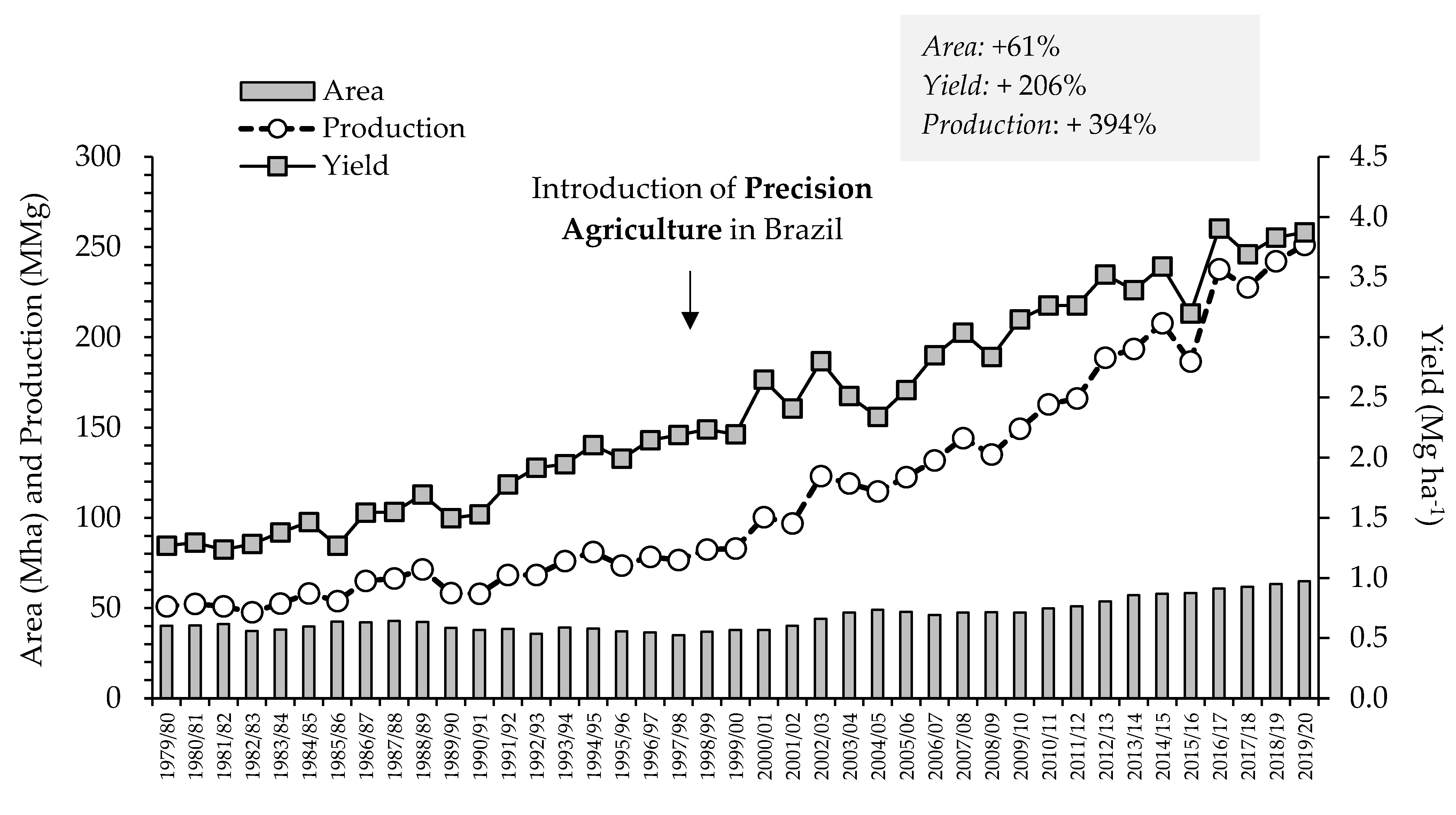

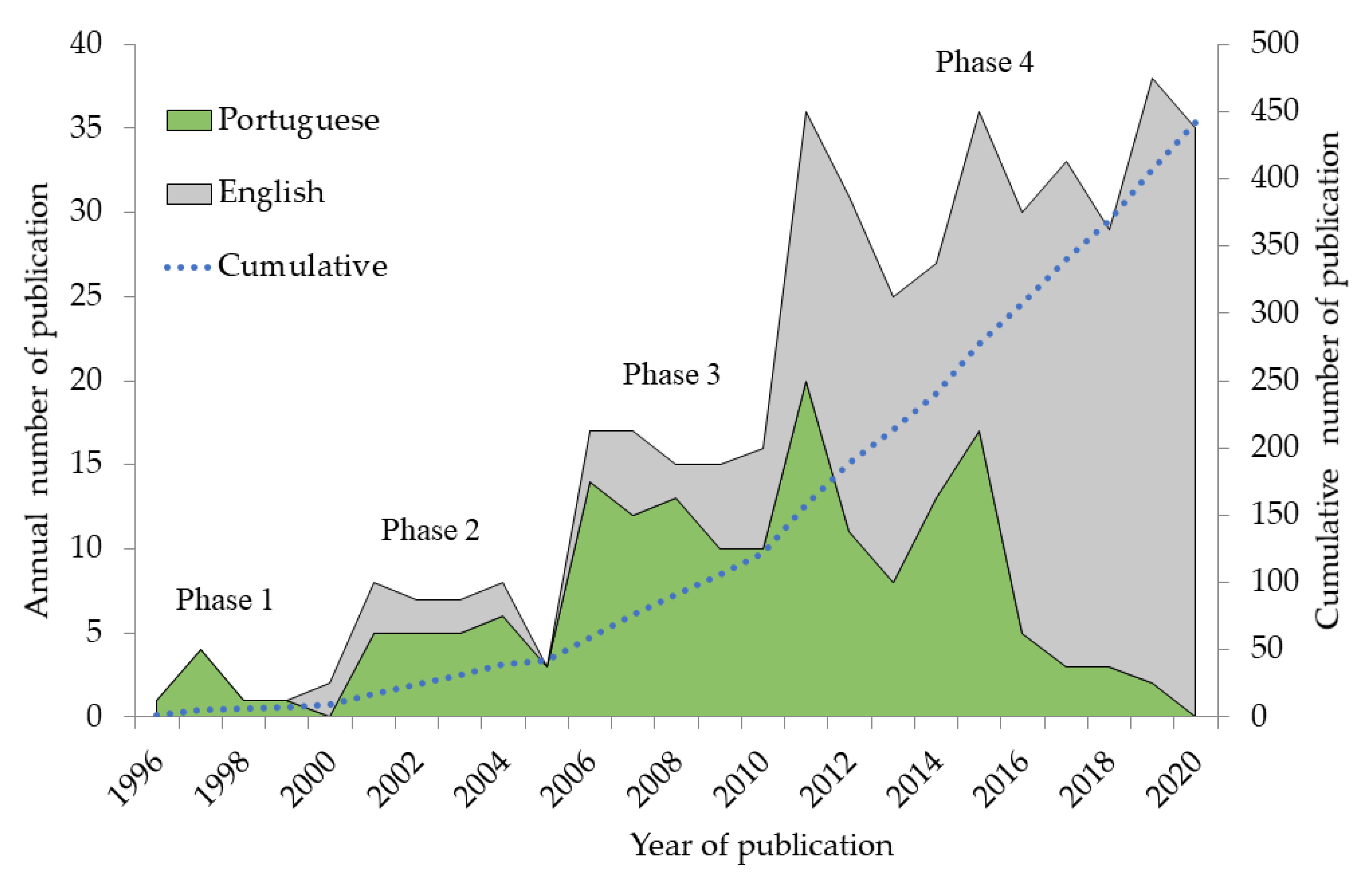
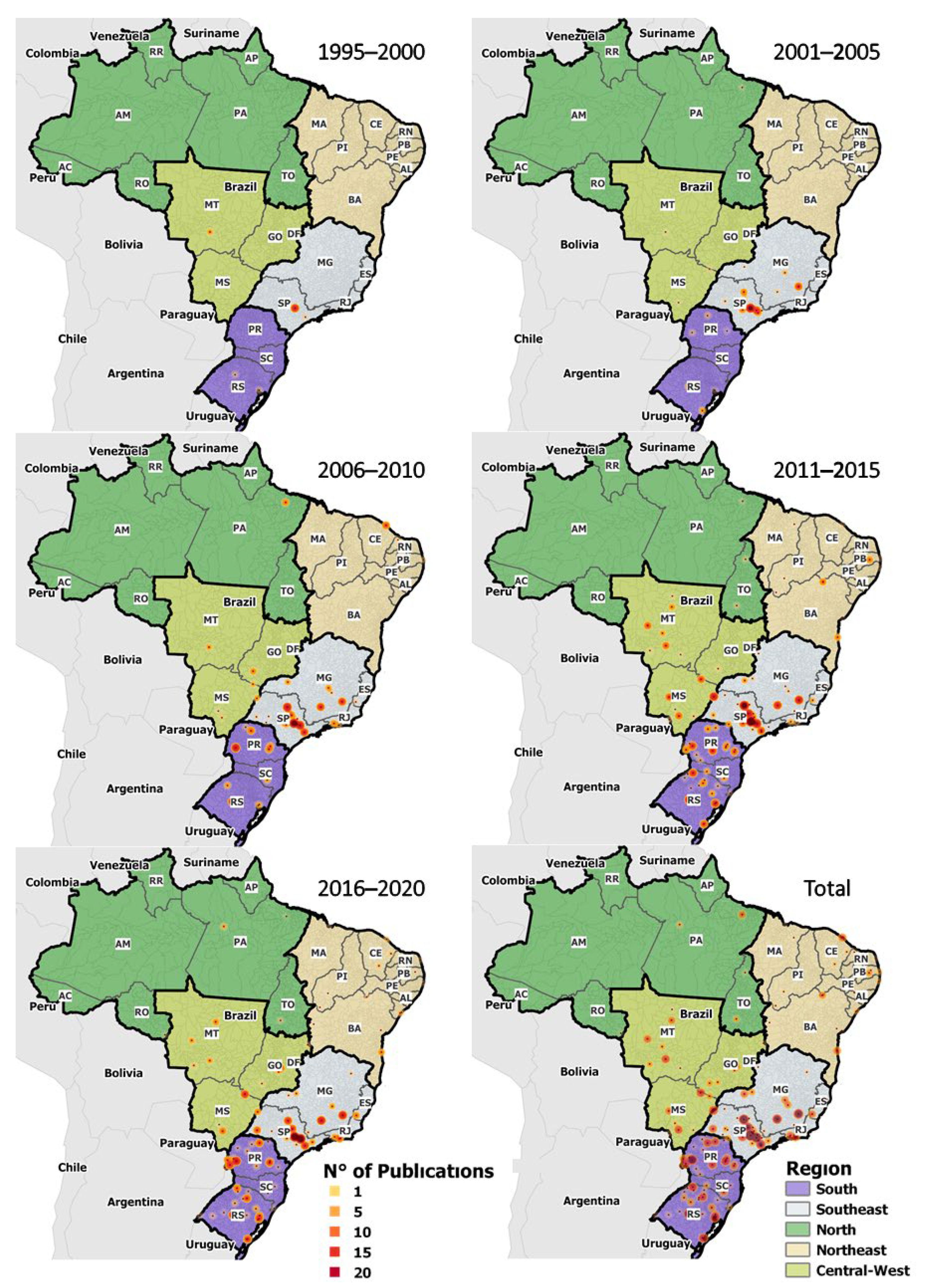
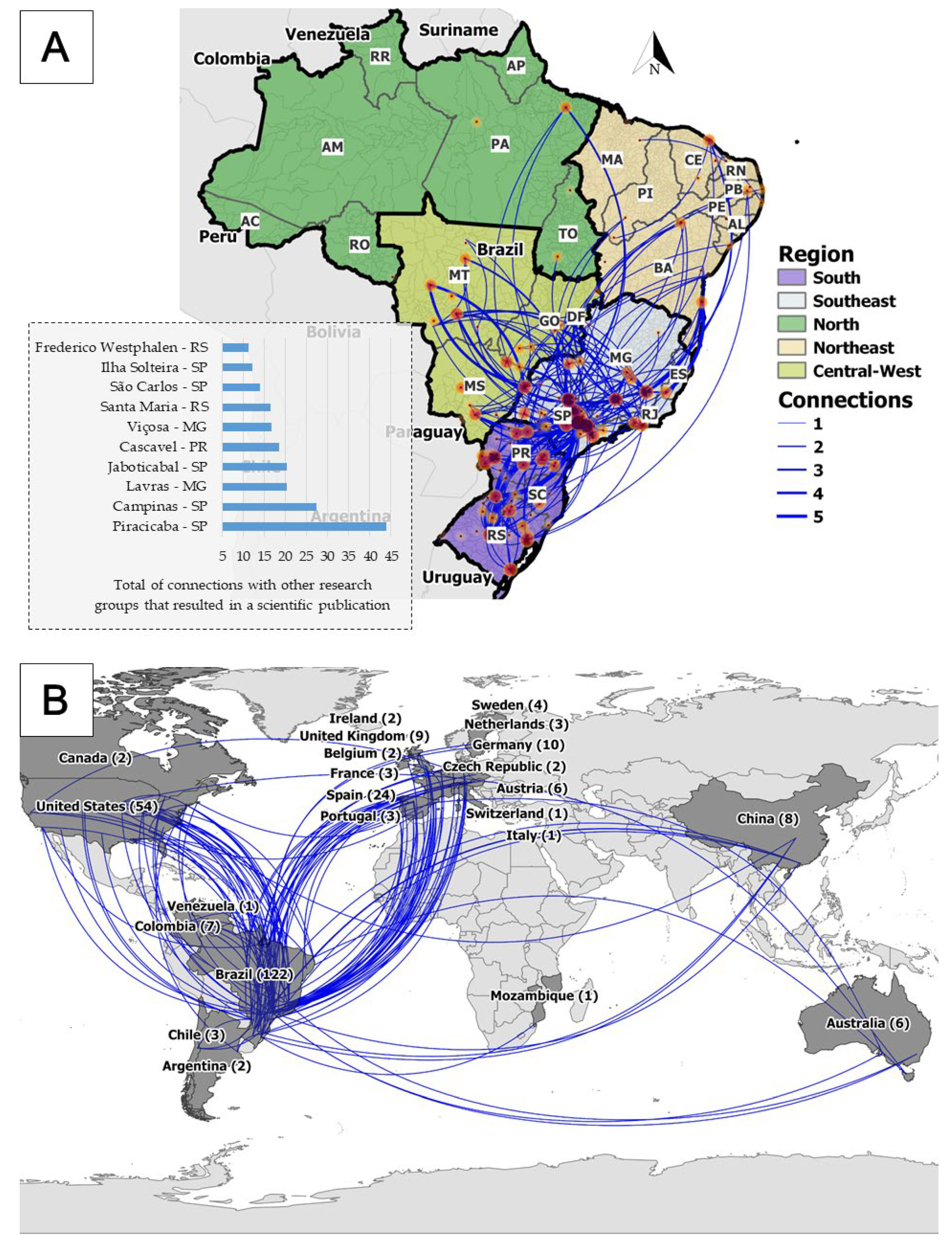

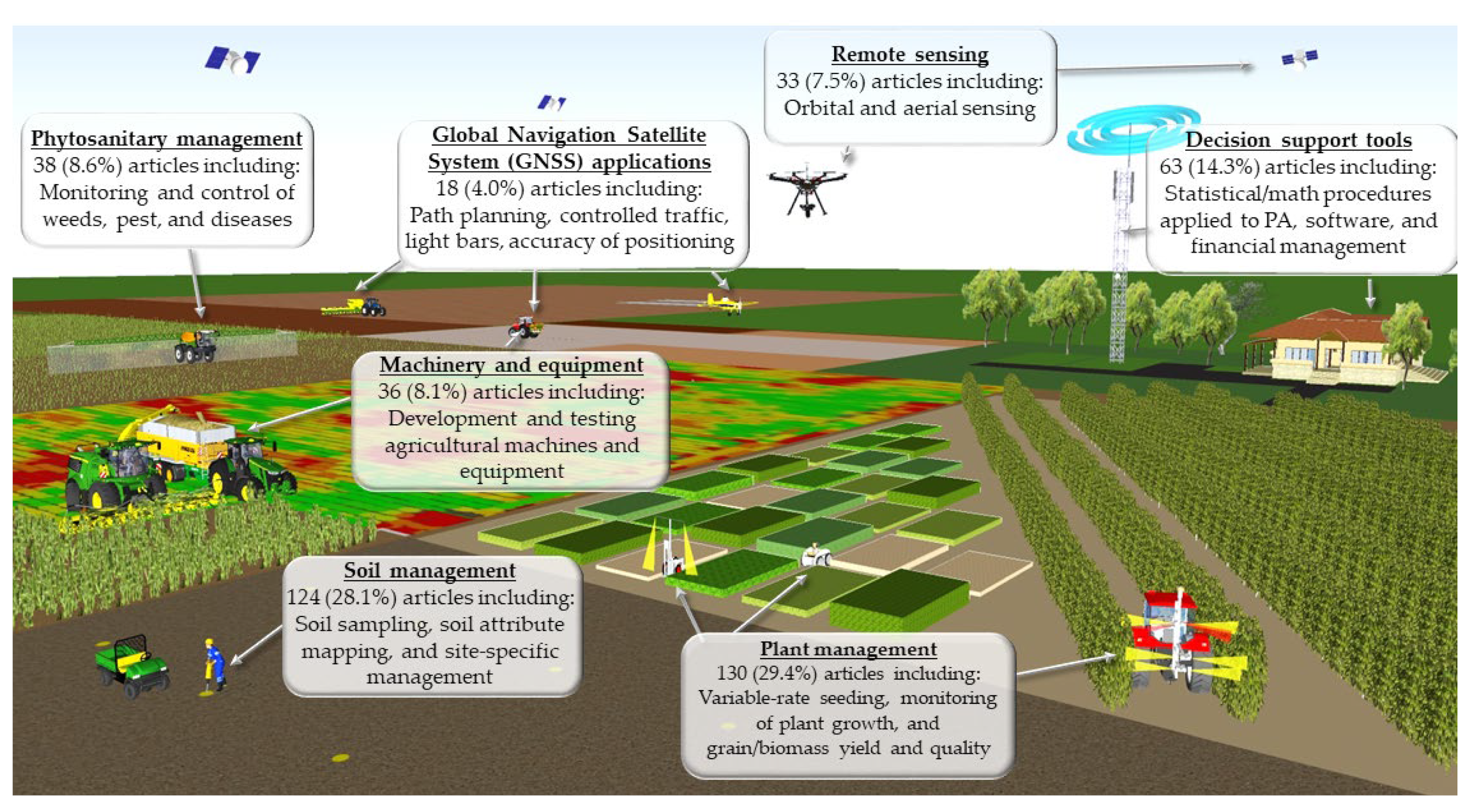
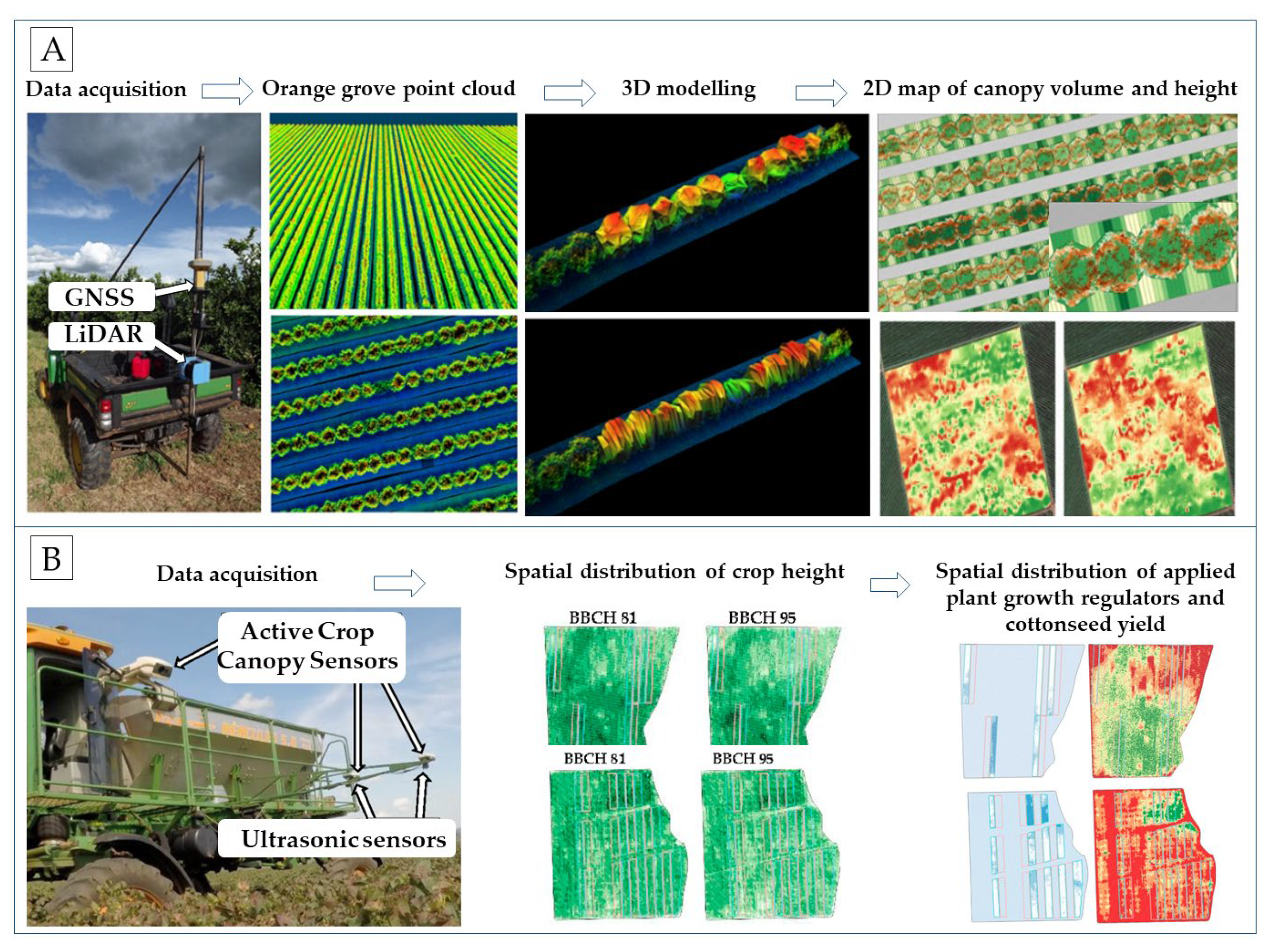
| Strengths | Weaknesses | Opportunities | Threats | |
|---|---|---|---|---|
| Soil management |
|
|
|
|
| Phytosanitary management | More rational and environmentally responsible use of agrochemicals. |
|
|
|
| Remote Sensing/UAV | Large-scale mapping with low cost compared to traditional soil and plant sampling and analysis. |
|
|
|
| Decision support tools | Data analytics, including protocols and modelling, for various purposes have been developed to provide high-quality spatial information for improved agronomic decisions. | On-farm decisions remain reliant on traditional agronomic frameworks that are not suitable for site-specific management. | Development of on-farm experimentation methods and protocols for the generation of large on-farm digital databases. | Difficulty in ensuring data quality for the construction of large datasets and data privacy issues. |
| Plant management |
|
|
|
|
| Machinery, equipment, and autonomous vehicles |
|
|
| |
| GNSS |
|
|
| Dependency on systems from foreign countries. |
Publisher’s Note: MDPI stays neutral with regard to jurisdictional claims in published maps and institutional affiliations. |
© 2022 by the authors. Licensee MDPI, Basel, Switzerland. This article is an open access article distributed under the terms and conditions of the Creative Commons Attribution (CC BY) license (https://creativecommons.org/licenses/by/4.0/).
Share and Cite
Cherubin, M.R.; Damian, J.M.; Tavares, T.R.; Trevisan, R.G.; Colaço, A.F.; Eitelwein, M.T.; Martello, M.; Inamasu, R.Y.; Pias, O.H.d.C.; Molin, J.P. Precision Agriculture in Brazil: The Trajectory of 25 Years of Scientific Research. Agriculture 2022, 12, 1882. https://doi.org/10.3390/agriculture12111882
Cherubin MR, Damian JM, Tavares TR, Trevisan RG, Colaço AF, Eitelwein MT, Martello M, Inamasu RY, Pias OHdC, Molin JP. Precision Agriculture in Brazil: The Trajectory of 25 Years of Scientific Research. Agriculture. 2022; 12(11):1882. https://doi.org/10.3390/agriculture12111882
Chicago/Turabian StyleCherubin, Maurício Roberto, Júnior Melo Damian, Tiago Rodrigues Tavares, Rodrigo Gonçalves Trevisan, André Freitas Colaço, Mateus Tonini Eitelwein, Maurício Martello, Ricardo Yassushi Inamasu, Osmar Henrique de Castro Pias, and José Paulo Molin. 2022. "Precision Agriculture in Brazil: The Trajectory of 25 Years of Scientific Research" Agriculture 12, no. 11: 1882. https://doi.org/10.3390/agriculture12111882
APA StyleCherubin, M. R., Damian, J. M., Tavares, T. R., Trevisan, R. G., Colaço, A. F., Eitelwein, M. T., Martello, M., Inamasu, R. Y., Pias, O. H. d. C., & Molin, J. P. (2022). Precision Agriculture in Brazil: The Trajectory of 25 Years of Scientific Research. Agriculture, 12(11), 1882. https://doi.org/10.3390/agriculture12111882












